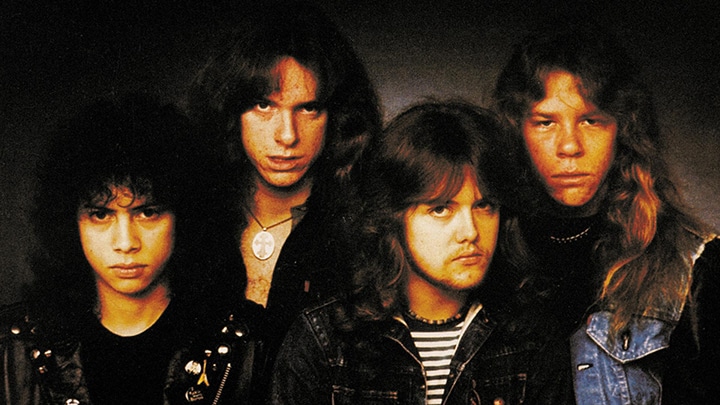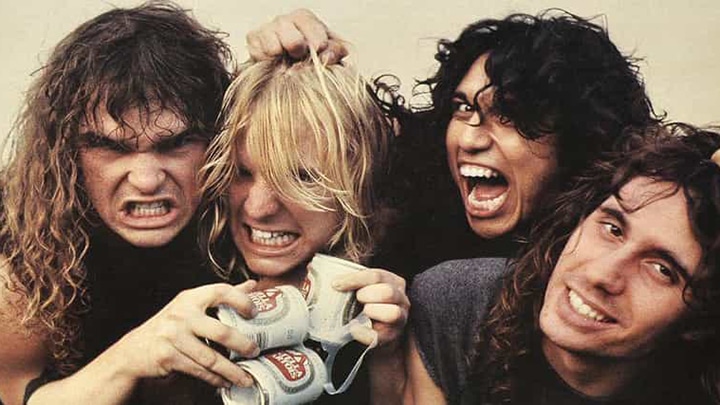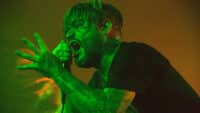Music

WTF is...?
WTF is… thrash metal?
As Metallica’s eleventh studio album looms and the metal heavyweights gear up for a landmark double-headline slot at Download, we take a deep dive into the sub-genre that started it all.
In the season four finale of Stranger Things, metalhead Eddie Munson dons a NJ Warlock electric guitar to deliver an electrifying performance of Metallica’s ‘Master of Puppets’ to distract a flock of deadly demobats. Within days, the title track of the band’s 1986 album skyrocketed back into the charts, inadvertently bringing thrash back into the spotlight almost four decades since the often-misunderstood sub-genre first emerged.
When you hear the words “thrash metal” you may envision long-haired, topless men throwing their horns up and cranking their amps up to eleven – and whilst some of those stereotypes check out – there’s a lot more to the movement that birthed some of metal’s biggest names.
Emerging in the early eighties as a response to the mainstream success of heavy metal bands like Van Halen and Def Leppard, a new generation of young musicians in the US and Europe began to fuse the raw DIY energy of punk with the technicality and virtuosity of British metal bands like as Iron Maiden and Motörhead. A new sound was born: faster, harder, and more aggressive than anything that came before it.
With its speeding low-end guitar riffs, heavy distortion, frenzied drums, and high-pitched screaming guitar solos, thrash metal has served as inspiration for generations of artists drawn to its speed, intensity, and chaotic spirit. From the rise of genre’s “Big Four” – Metallica, Slayer, Anthrax, and Megadeth – to the understated key-players who would go on to inspire Florida’s death metal explosion and Norway’s iconic black metal scene, thrash metal has left an indelible mark on the world of music and beyond.
Still struggling to grasp how a band of San Francisco metalheads managed to forge a career so illustrious that they’re still headlining festivals forty years after their debut? Let’s dive a little deeper.
The beginnings of thrash

Countless debates have taken place about where thrash metal truly began. Some claim it was with Newcastle band Venom’s 1981 debut album, Welcome To Hell. Others even argue that Queen’s ‘Stone Cold Crazy’ was among the first thrash songs due to its fast tempo and heavy distortion. A sub-genre born and bred in the metal underground where the basements were often as hazy as the heads of those within them, there’s no real record of thrash’s beginnings, but the early Bay Area scene was integral.
Having moved from LA to San Francisco in 1982 to escape their hometown’s flourishing hair metal scene, Metallica released their debut album, Kill ‘Em All, in 1983, just before Slayer gave us Show No Mercy in the same year. The records set the template for thrash metal by combining breakneck speed, intricate riffs, and intense vocals, even though the term “thrash” wasn’t coined until a review of Anthrax’s Fistful Of Metal in 1984. The sub-genre had been born.
In its earliest days, thrash’s sound was partially driven by Metallica’s fiery founding guitarist Dave Mustaine, though the virtuoso’s tenure in the band was infamously short, sacked and replaced by Exodus’ Kirk Hammett before their debut album release. However, a rage-fuelled mission for vengeance led Mustaine to the formation of Megadeth, whose 1986 album Peace Sells… But Who’s Buying? saw the full realisation of the guitarist’s creative genius.
Other important early thrash scenes included New York City, where Anthrax and Overkill formed, and Germany where bands like Kreator, Sodom, and Destruction developed their own take on thrash metal, known as ‘Teutonic thrash’.
Thrash metal’s breakthrough

1986 was a pivotal year for thrash. Mocked and maligned by the wider rock world throughout the early eighties, by the middle of the decade thrash had amassed a collection of world-class players setting new standards in the heavy music world.
By then, Metallica, Slayer, Anthrax, and Megadeth were established as the frontline of bands that drove the scene with their technical skills and warp-speed riffs. Between 1986 and 1987, each released albums that redefined the face of metal. Metallica’s Master Of Puppets was a cutting-edge album that showed the band to be true innovators, while Slayer’s Reign In Blood showcased a malevolent sound few could match. Anthrax’s Among The Living featured fast breakdowns and more melodic influences, and Megadeth’s Peace Sells… But Who’s Buying? was a Mustaine masterclass.
While the Big Four led the charge, other bands were developing their own sound in the B-league, with record labels keen to cash in on the thrash wave. Bands like Annihilator, Exodus, and Testament continued the Bay Area legacy, the UK boasted the likes of Onslaught and Sabbat, whilst over in South America Brazil’s Sepultura were becoming seemingly unstoppable.
As the 1980s progressed, thrash metal continued to evolve and diversify, with bands across the world pushing the boundaries of the sub-genre on each new release. Challenging the mainstream music industry and paving the way for independent labels and DIY culture, the Big Four dominated increasingly larger stages across the world and the underground continued to thrive. But the words ‘sell out’ were starting to sit on the tip of many tongues in sweaty basements…
The thrash legacy

By the late 80s, thrash had become a commercial force. Metallica’s run of support slots on Ozzy Osbourne’s monumental 1986 Damage, Inc. Tour exposed the sub-genre to arenas across the U.S., while Slayer’s Rick Rubin produced Reign In Blood hit the Billboard 200.
As record labels scrambled to find “the next Metallica” amidst the underground scene, thrash’s focus shifted. With grunge dominating the mainstream, it was time to evolve, and Metallica’s 1991 divisive commercial leap did just that. Shedding some of their thrash roots, the band’s seismic Black Album moved beyond genre, embracing innovation at every turn.
Despite the backlash from fans and critics alike, the record opened up new avenues for exploration and experimentation within thrash metal that would eventually define its legacy. Inspired by the evolution, Texan band Pantera and Robb Flynn’s mighty Machine Head headed up a post-thrash scene that retained the fast breakdowns and jarring tempo changes but embraced groove. Slayer’s viciousness, alongside the extreme tendencies of bands like Kreator and Sodom inspired the death metal scene in Florida and Sweden, whilst Norway was exploring the beginnings of its infamous black metal scene, and Muncipal Waste revitalised the classic Bay Area sound.
A violent metal revolution fuelled by fanzines, tape-trading, and a near constant one-upmanship in aggression, thrash metal’s influence can be heard in everything today from death metal and metalcore to punk rock. With bands such as Lamb of God and Trivium carrying the torch whilst the Big Four still blaze through sold-out world tours, releasing music that continually evolves and inspires – thrash metal lives on in countless brilliant forms.
Essential listening
Metallica – Kill ‘Em All (1983). The debut album that arguably started it all.
Metallica – Master Of Puppets (1986). Widely considered one of the greatest metal albums of all time, ‘Master Of Puppets’ showcases Metallica’s technical prowess and songwriting skill, with classics like ‘Battery’, ‘Welcome Home (Sanitarium)’, and the historic title track.
Slayer – Reign In Blood (1986). A landmark album in thrash metal history, Reign In Blood is a 29-minute onslaught of speed, aggression, and brutality. From the opening track, ‘Angel of Death’, to the closing track, ‘Raining Blood’, Slayer’s masterpiece leaves no survivors.
Megadeth – Peace Sells…But Who’s Buying? (1986). The second album from Dave Mustaine’s gang is a thrash metal classic. Featuring ‘Wake Up Dead’ and ‘Devils Island’, the guitarist’s distinctive playing and biting lyrics set Megadeth apart from their peers.
Anthrax – Among The Living (1987). Anthrax’s third album is a thrash metal masterpiece, featuring the anthemic ‘Caught in a Mosh’, the socially conscious ‘Indians’, and the horror-inspired ‘A Skeleton in the Closet’.
Testament – The New Order (1988). Testament’s second album solidified their place as one of thrash metal’s essential bands. With tracks like ‘Disciples Of The Watch’, and ‘The Preacher’, ‘The New Order’ showcases Testament’s technical skill and melodic sensibility.
Exodus – Bonded By Blood (1985). Exodus’ debut album is a raw and uncompromising thrash metal classic, featuring essential tracks such as ‘A Lesson In Violence’, and ‘Strike Of The Beast’. The album’s aggressive and confrontational sound set the tone for thrash metal’s early years.
Kreator – Pleasure To Kill (1986). Germany’s Kreator released one of the most brutal and intense thrash metal albums of all-time. Tracks like ‘Riot Of Violence’, and ‘Command Of The Blade’ showcase the band’s ferocious sound and uncompromising lyrics.
Power Trip – Nightmare Logic (2017). Texan band Power Trip combine elements of thrash metal and hardcore punk, with their politically-charged lyrics tackling issues such as police brutality and government corruption. Their second album was widely acclaimed upon its release and cemented their status as one of the most exciting bands in modern thrash metal.
Muncipal Waste – The Art Of Partying (2007). A crossover thrash band known for their high-energy performances and humorous lyrics, Municipal Waste have become one of the leading bands in the modern thrash metal scene, and this record is considered a modern classic of sorts.
Photo credit: Jeff Kravitz / Getty









